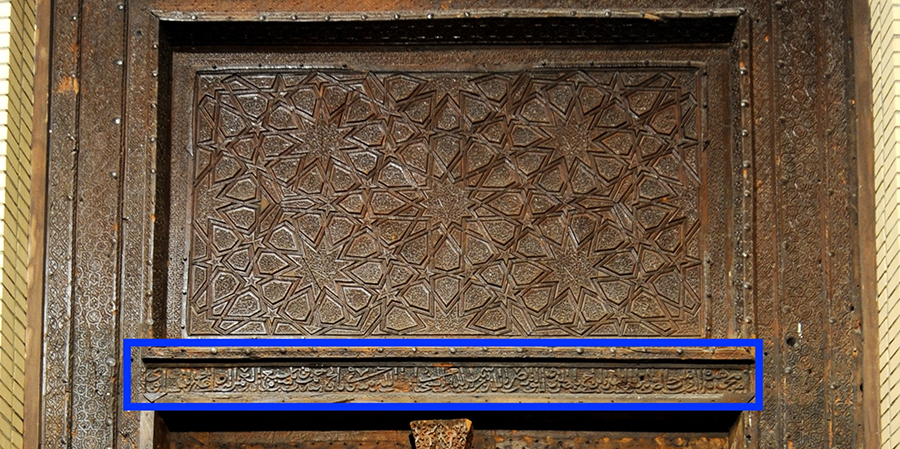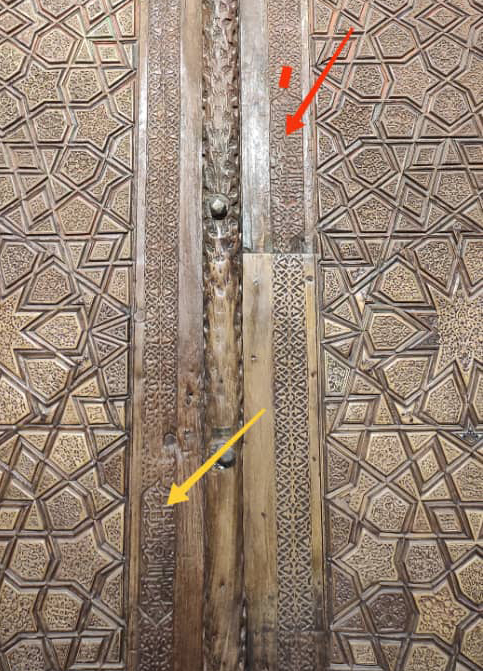*This is an English translation of the original catalog entry in Persian
14Oldest wooden door of the Shrine of Emam Reza (AS) at Mashhad

Iran, Kharazmshahi period (ca. 1077–1231) Restored during the Ilkhanid (735/1334–35) and Qajar (1775–1925) periods H. 15 ft. × W. 4.49 ft. (H. 460 × W. 260 cm) Astan-e Qods-e Razavi Museum, Mashhad, no. 1265 alef (الف) Photograph ©︎ Organization of Libraries, Museums and Documents Center of Astan-e Qods-e Razavi
This is the oldest wooden door of the Shrine of Emam Reza (AS) and consists of an outer frame, two door panels, and three inscriptions. Its production likely dates to the Kharazmshahi period (خوارزمشاهی, ca. 1077–1231), around the time when major renovations were carried out in the shrine (see cat. no. 16). For many years, this door was installed at the main entrance to the shrine at the north end of the Dar al-Siyada (دارالسیاده), a large chamber to the west of Emam Reza’s tomb (fig. 1) [also see this plan on Archnet]. After repairs and restorations of the shrine’s prayer halls, the door was moved to the Astan-e Qods-e Razavi Museum. No photograph of the door in situ is known.

Also known as the door of ‘the Qazi al-Hajat’ (قاضی الحاجات, granter of needs), this immense door has two panels, each measuring 9.6 by 3.2 feet (fig. 2). It is made of boxwood and decorated with intricate wood carving and knotwork (منبتکاری و گرهچینی). Many areas of the door show traces of ultramarine, rust, and red pigments.

Two inscriptions added during later historical periods attest to the value and importance of this door, as well as the desire to preserve and repair it. The first, made of plane tree wood, is written across the upper section of the door (fig. 3). This inscription states that Master ʿAli Najjar Neyshaburi restored the door at the order of Nasrallah b. Shams al-Din Sanjani in 735/1334–35. The text reads:
امر بتجديد هذالباب من خالص ما له العبد المذنب الراجي ناصرالدوله والدين نصرالله ابن شمس الدين السنجانی
[تقبل] الله منه في تاريخ سنه خمس وثلثين و سبعمائه بعمل استاد علي نجار نيشابوري
He ordered the restoration of this door from the pure possessions of the sinful servant, Al-Raji Naser al-Dowlah and al-Din, Nasrallah ibn Shams al-Din al-Sinjani. May God [accept] it from him on the date of the year seven hundred and thirty-five, the work of Master ʿAli Najjar Neyshaburi.

The second repair inscription indicates that the door was restored during the Qajar (1775–1925) period at the order of Mirza Fazlullah Amir Nezam, the custodian (motevalli) of the shrine. This inscription consists of two cartouches (کتبیهی قلمدانی) on either side of the central tongue of the door’s two panels (fig. 4). It reads:
قد امر بتزيين هذالباب الرفيع ذالجلال الرياستين
امير فضل الله متولّي باشي سرکار و وزیر نظام دولت علیه ایران
It was ordered to decorate this noble door of great majesty
Amir Fazlullah Motevalli Bashi, sarkar and vazir of the Iranian government
(Kafili 2018–19, p. 263; Kafili 2017–18, p. 64; Kafili 2024, p. 116)

Sources:
- کفیلی، حشمت. آثار چوبی منبتکاری حرم امام رضا علیه السلام. مشهد: بنیاد پژوهشهای اسلامی، ۱۳۹۷ش. [Kafili, “Asar-e chubi monabbat-kari-ye Haram-e Emam Reza (AS),” “Inlaid Woodwork of the Shrine of Emam Reza,” 2018–19]
- کفیلی، حشمت، مریم حبیبی و محمدرضا شاهرودیزاده. موزههای آستان قدس رضوی. تهران: پژوهشگاه میراث فرهنگی کشور با همکاری سازمان کتابخانهها، موزهها و مرکز اسناد آستان قدس رضوی، ۱۳۹۶ش. [Kafili et al., Muzeh-ha-ye Astan-e Qods-e Razavi, Museum of Astan-e Qods-e Razavi, 2017–18] [Aui.ac]
- کفیلی، حشمت. «قدیمیترین در چوبی حرم امام رضا (ع)». در: جام جهان بین. مشهد: سازمان کتابخانهها، موزهها و مرکز اسناد آستان قدس رضوی، ۱۴۰۳ش. [Kafili, “Qadimitarin dar-e chubi-ye Haram-e Emam Reza (AS),” “Oldest Wood Door of the Shrine of Emam Reza,” 2024] [Aparat]
Citation: Heshmat Kafili, “Oldest wooden door of the Shrine of Emam Reza (AS) at Mashhad,” translated by Hoda Nedaeifar. Catalog entry in The Emamzadeh Yahya at Varamin: An Online Exhibition of an Iranian Shrine, directed and edited by Keelan Overton. 33 Arches Productions, January 15, 2025. Host: Khamseen: Islamic Art History Online.
